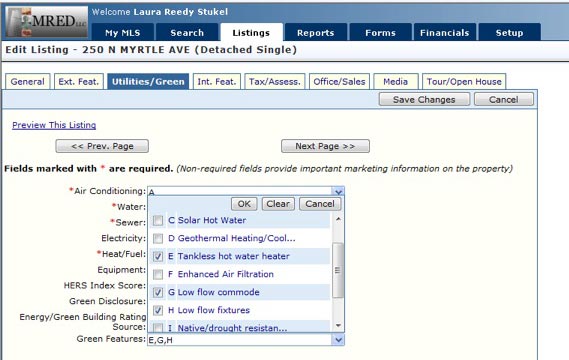
Along with the size of the lot and the number of bedrooms a property has, a seller,s real-estate agent can also opt to disclose ten individual green features.
Shopping for a home with a green roof, solar water heater, low-water landscaping, or other eco-features got a lot easier in mid-December when Midwest Real Estate Data (MRED), the Chicago-area multiple listing service, incorporated a list of green options in all listings. Now, along with the size of the lot and the number of bedrooms a property has, a seller’s real-estate agent can also opt to disclose ten individual green features or levels of LEED certification. The green profile of a for-sale home “is something more and more people are asking about,” says Bud Fogel, MRED’s CEO. “I think long term it’s going to be really significant.”
The new green list could really get a boost if the federal government rolls forward with a “cash for caulkers” program that directs stimulus funds toward energy-saving home retrofits, says John Shaterian, an @Properties agent who was one of five real-estate agents who devised the list and proposed it to MRED leadership. “If you’ve tightened up your home and increased its HERS [Home Energy Rating] score,” Shaterian explains, “you can reflect that in your listing when you go to sell. It gives you a reward for doing those things” in the form of a well-organized marketing tool.
Before the recent change, agents who wanted to tout a property’s green features could put them in the notes section of a listing sheet—the descriptive part near the bottom of the sheet where an agent waxes eloquent about a home’s charms—but that is not a field that a buyer’s agent can search automatically. Now, an agent whose buyer wants a house with solar panels can do a one-click search for all available homes that have that equipment. Filling the boxes is not required (unlike such attributes as number of bedrooms, property taxes, and schools); they are there for the people who want to use them, Shaterian says. That’s true, as well, of the green disclosure form that a seller can now attach to a listing. “The onus is really on the seller to share this information,” Shaterian says. “It’s not mandated.”
Of the more than 800 multiple listing services in the United States, Shaterian says, about 20 or 30 have green items in their listings, with Seattle, Santa Barbara, San Antonio, and Traverse City among the leaders. When Shaterian and other agents began investigating the concept, they expected it would take a couple of years before MRED would adopt the green list; instead, the agents made their proposal in October, and MRED launched the list December 17th.
So far, MRED hasn’t been able to count how many listings have incorporated the green list. “It’s going to take a while for there to be awareness of it,” Fogel says. But for those buyers or sellers who prefer to traffic in information on green features of a home—however few or many they may turn out to be—the green list is a considerable step forward for the Chicago real-estate market.
Also: On Tuesday, January 5th, Walter Jacobson, the retired news anchor who worked at WBBM–Channel 2 and WFLD–Channel 32, closed on the $1.975-million sale of a Lincoln Park house that he had owned twice. Information from the Cook County Recorder of Deeds shows that, in 1994, Jacobson and his third wife, Susie, paid $750,000 to buy the 13-room house from his first wife, Lynn Straus. He and Straus had bought the house in the 1970s when married (the Recorder of Deeds has no information on what they paid then). The house, which had an asking price of $2.2 million, was built in 1893 and has, according to the listing sheet, a lavish kitchen, a third-floor family room, a rooftop deck, and a nice garden with a gazebo.


